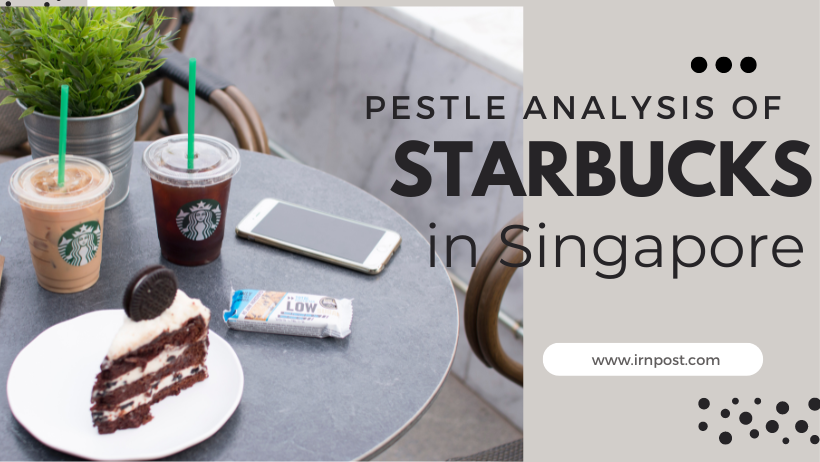Business
Pestle Analysis of Starbucks in Singapore

To better understand the macro-environment of Starbucks in Singapore, a PESTEL analysis will be conducted. There are 130 stores of Starbucks with revenue of $135.3 Million in Singapore.
1. Political Factors:
The political environment in Singapore is relatively stable, with the ruling party enjoying significant popular support. This has created a conducive environment for businesses to operate in, and has helped Starbucks to expand rapidly in recent years. However, rising costs associated with doing business in Singapore (e.g. high rents and wages) could pose a challenge for the company in the future.
If you want assignment or essay writing services you can email us at Email Us. or directly email here writing@irnpost.com.
The government is supportive of foreign investment and there are few restrictions on businesses operating in the country.
However, businesses should be aware of the following political risks:
- The possibility of changes in government policy that could adversely affect business operations.
- The potential for political unrest or violence that could disrupt business operations.
- The risk of corruption when doing business in Singapore.
- The possibility of regulatory changes that could impact business operations.
- The potential for economic sanctions being imposed on Singapore that could disrupt business operations.
- The risk of expropriation of property or assets by the Singapore government.
- The possibility of adverse tax changes that could impact business profitability.
- The potential for restrictions on the free movement of people, goods, and capital that could disrupt business operations.
- The possibility of trade disputes with other countries that could adversely affect business operations.
- The potential for geopolitical risks that could impact business operations.
2. Economic factors:
The Singaporean economy is currently in a strong position, with GDP growth forecast to remain healthy in the coming years. This positive economic outlook provides a good opportunity for Starbucks to continue growing its business in Singapore. However, rising costs could increasingly become an issue for the company in the future.
The high cost of living in Singapore: The high cost of living in Singapore is a major challenge for Starbucks. According to a report by the Economist Intelligence Unit, Singapore is the most expensive city in the world for expatriates. This means that Starbucks has to charge higher prices for its products in order to cover its costs.
The competition from local coffee chains: There is stiff competition from local coffee chains in Singapore. For instance, Kopi Tiam and Ya Kun Kaya Toast are very popular among locals. This means that Starbucks has to fight for market share in the country.
The limited growth potential of the Singaporean market: The limited growth potential of the Singaporean market is another challenge for Starbucks. This is because the market is already quite saturated and there are not many new customers to be attracted.
Despite these challenges, Starbucks has been doing well in Singapore. The company has registered strong growth in recent years and has plans to open more stores in the country. This shows that the company is confident about its prospects in Singapore.
3. Social factors:
Singaporeans are generally well-educated and have a strong appreciation for coffee culture. This has helped to drive demand for Starbucks’ products, and the company has been able to tap into this trend by opening a large number of outlets in recent years. Going forward, Starbucks is likely to continue benefiting from the growing popularity of coffee culture in Singapore.
The coffee chain has been very popular in Singapore since it opened its first store in 1996. The company now operates more than 84 stores across the island.
However, Starbucks’ recent decision to raise prices by up to 20 percent has not gone down well with customers here. Many have taken to social media to express their displeasure, with some even pledging to boycott the brand.
So what could be behind this price hike?
Some experts have pointed to the rising cost of coffee beans as a possible factor. The price of Arabica coffee, which is the type of bean used by Starbucks, has surged by more than 60 percent over the past year.
Other factors that may have contributed to the price increase include the rising cost of rent and labor in Singapore.
Whatever the reasons, it is clear that the price hike has not been received well by Starbucks’ customers in Singapore. Only time will tell if the company will be able to weather this storm.
4. Technological factors:
The use of technology is pervasive in Singapore, and this has helped Starbucks to improve its operations and reach more customers. For example, the company has introduced mobile apps that allow customers to order and pay for their drinks electronically. In the future, Starbucks is likely to continue benefitting from the use of technology in Singapore.
The high-tech equipment that Starbucks use in their stores helps them to keep up with the competition and offer a great experience to their customers. The store environment is very important to customers and by using the latest technology, Starbucks can create a unique atmosphere. For example, they use touch screen ordering which makes it easy and quick for customers to order their drinks.
The use of technology has also helped Starbucks to improve their customer service. By using WiFi, customers can stay connected while they are in the store and this helps to create a relaxed atmosphere. In addition, the use of mobile apps means that customers can order their drinks before they arrive at the store, which saves time.
Starbucks has also invested in technology to help them manage their supply chain more effectively. They use a computerized system to track their inventory and this helps them to ensure that they always have the supplies needed to meet customer demand. This efficient supply chain management means that Starbucks can offer a consistently high level of service to their customers.
Overall, the use of technology has helped Starbucks to create a more efficient and enjoyable experience for their customers. By investing in the latest technology, they are able to stay ahead of the competition and offer a great service that keeps customers coming back.
5. Legal factors:
The legal framework in Singapore is generally favourable for businesses, and this has helped Starbucks to operate without any major legal issues. However, the company will need to comply with new regulations that have been introduced in recent years, such as the requirement to label all food and beverage products with nutritional information.
The legal factors affecting Starbucks in Singapore are largely related to the country’s stringent food and beverage regulations. For example, all food and beverage businesses in Singapore must obtain a food license from the relevant authorities before they can operate. Additionally, all food and beverage products must comply with the country’s food safety standards.
Another legal issue that Starbucks has to deal with in Singapore is the country’s high taxes on imported coffee beans. Currently, imported coffee beans are subject to a 20% customs duty. Additionally, Starbucks has to pay a 10% Goods and Services Tax (GST) on all its coffee products sold in Singapore.
Despite the challenges posed by the legal environment, Starbucks has been able to successfully operate in Singapore for many years. The company has a strong presence in the country, with over 100 stores currently in operation. Additionally, Starbucks has a well-established supply chain and a loyal customer base in Singapore.
Looking forward, it is likely that the legal environment in Singapore will continue to pose challenges for Starbucks. However, the company has a track record of success in the country and is well-positioned to continue growing its business in Singapore.
6. Environmental factors:
The environmental conditions in Singapore are generally favourable for businesses, with the city-state being relatively free of pollution. This has helped to create a conducive environment for Starbucks to operate in and expand its business. However, rising temperatures and sea levels associated with climate change could pose a challenge for the company in the future.
The high population density of Singapore, which is about seven times that of New York City, results in land scarcity. This environmental factor affects Starbucks because it must compete with other businesses for limited space to build new stores. Additionally, Starbucks must pay high rents for its retail locations. The company also faces challenges related to water availability and wastewater treatment due to Singapore’s limited freshwater resources.
In order to address these environmental factors, Starbucks has implemented a number of sustainability initiatives in its operations in Singapore. For example, the company has installed water-efficient fixtures in its stores and uses reclaimed water for irrigation at its roastery. Additionally, Starbucks has partnered with local organizations to support tree planting projects and other green initiatives.
Conclusion
According to PESTLE analysis of starbucks in Singapore. More generally, some people argue that Starbucks represents the homogenization of global culture, and that its presence in Singapore (and other countries) is detrimental to local businesses.
Overall, it’s hard to say whether Starbucks is doing good or bad in Singapore. What do you think?
















